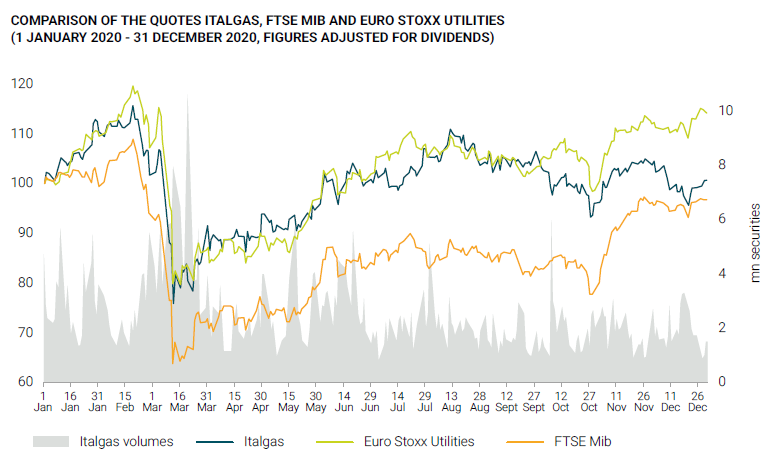The COVID-19 pandemic, which broke out in late February 2020 and is still ongoing, is putting the resilience of Italy’s entire social, healthcare, political, economic and industrial fabric to the test. Faced with a situation of severe instability, Italgas reacted promptly from the outset to protect the health and safety of its people, while ensuring the continuity of essential services to the over 7.7 million customers served in 1,887 municipalities nationwide7.
Decisions relating to the health emergency and organisation of work were immediately entrusted to an internal Crisis Committee, composed of the heads of the company’s main departments. This Committee operated in line with the national health provisions and in continual contact with local and national competent authorities.
The utmost attention was paid to protecting employees. The Company took out specific COVID-19 insurance, provided free prevention measures (voluntary serological, antigen and molecular tests) and immediately procured and distributed safety equipment (masks, gloves, coveralls, sanitiser gels) to all offices and technical units. Employees are also continually updated by means of regular memos on the regulatory measures stemming from the Government Decrees and any repercussions on work activities which, where not strictly necessary, were, and still are to this day, carried out remotely in smart working mode.
The digitisation process of networks, processes and people, launched in 2017, facilitated the prompt reorganisation of work. In the short space of a weekend, from 7 to 9 March 2020, during implementation of the measures set by the government for the first lockdown, we were able to transfer most activities online, with no repercussions for day-to-day operations.
Use of the cloud and provision of a number of digital devices for all personnel reduced mobility and enabled smart working across Italy. With activities organised in this way, the average number of people connected every day via collaboration platforms on all devices (Teams, Zoom, Webex, etc.) rocketed from 200 to over 2000 in just 24 hours. These numbers are significant, and, at full potential, with the ongoing limitations on unnecessary travel, a daily average of 2,100 people were recorded as being operative, with almost 1,000 virtual meetings and 30,000 (with peaks of 35,000) messages in chat.
The effects of the digital transformation of assets and processes have brought structural benefits, including for the reduced movement of people working on technical activities. With the development and use of innovative technologies, such as “Gas Leakage Detection”, “Shareview” and “WorkOnSite”, it was possible to manage the network remotely and efficiently, increase checks in the local area and reopen and manage the worksites in complete safety from as early as May 2020, during the first relaxing of the restrictive measures.
The Italgas Group also took steps to support the national health system, by donating to 7 hospitals up and down the country and to the Civil Protection. The Group’s employees also contributed to these initiatives by joining the charity campaign “Insieme per l’Italia, dona una tua giornata alla lotta contro il Coronavirus” [Together for Italy, donate your day to the fight against Coronavirus], which collected the equivalent in money of approximately 7,000 hours of work, an amount which was then doubled by the company.
Significantly adverse effects of the ongoing pandemic are not reasonably foreseeable on the Italgas business model. The Group has proven that it is able to react promptly and effectively to the difficulties encountered, guaranteeing its usual operating efficiency while continuing to protect its people. The operating and economic effects of interrupting the activities and the resulting delays in the implementation of the corporate plans were significantly absorbed during the year, showing just how resilient the company is when faced with events of this nature and entity.
For more information, see the “Coronavirus Emergency and Business OutlookThe outlook indicates the future rating prospects over a long period of time, usually two years. When it is “negative” it means that the rating is weak and that the rating agency has detected some” paragraph in this document.

